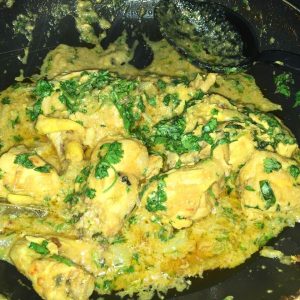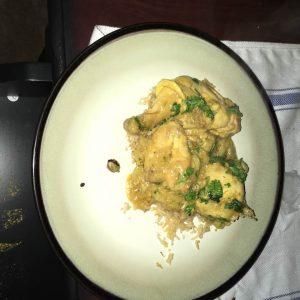So, back in October 2010 I wrote something:
I find it somewhat remarkable that I, born and raised in Fremont, California, now resident in Vienna, Austria, can lift the lid from a pot on my stove and smell my grandmother’s kitchen in Kolkata, India. It is deeper than muscle memory, and perhaps even deeper than sense memory. It is almost primordial, tapping into the reptilian part of my brain which remains hard-wired to crave the comfort of rice, boiled eggs, potatoes, and ghee when I feel unmoored.
I am the product of generations of fierce women, strong, courageous, some of them progressive to the point of perceived radicalism. And all of them, as far as I know, have shown their love through cooking and feeding people. My own mother, herself well-loved, cosseted, even, managed to make it to the age of 21 rarely having prepared a meal. Then she married my father, in a leap of faith which only time proved was not entirely foolhardy or just plain crazy. She moved halfway around the world- as I find myself doing, every 2-3 years, though in my case I have pledged myself to the United States government. I suppose my choice is no more explicable, and State was pretty much a stranger to me when I signed the contract, too.
In any case, my mother found herself a young, new bride in a foreign land and had to learn to recreate the tastes of home. She had help, both from my father, who had missed Bengali food so much that he learned basic dishes, and from fellow wives who were a few years ahead of her as immigrants. Indian grocery stores were few and far between then, and trying to cobble together ingredients must have been difficult. Nevertheless, she enjoyed being in the kitchen, and she, too, had a deeply rooted sense of hospitality. It was unthinkable that she would not demonstrate her care for family and friends through that time-honored tradition, nemonthonno, the inviting of people for a meal.
As far back as my childhood memories stretch, my mother has been an exceptional cook. Even when she first started a business, she could prepare the family dinner within an hour of getting home. Four burners meant rice, lentils, a vegetable, and chicken or fish, for the most part. I grew up watching her cook, hearing stories of both her own mother and my dad’s, the types of dishes that people no longer made because it was too much effort. Never too difficult for my mom, though. She kept the old traditions alive, but introduced shortcuts and adapted with new ingredients. How she learned to recreate mishti doi (Bengali sweet yoghurt) in an American kitchen is perhaps something I should ask her!
Now I find myself following in her footsteps. I move to foreign countries, I try to figure out the food, and then I find a way to cook the dishes that taste of my childhood. It is one of the small ways I carry my home with me, like a snail or a turtle or a nomad. It is a link to my heritage, an unshakeable connection, which, more than speaking Bengali or occasionally wearing a sari, reminds me of my personal history. Like our cooking, and like all the women in my family, it is layered, complex, a balance of sweet and savory, richly textured, and not easily conveyed in a mere recipe.
I realized that what prompted that note was how my own grocery shopping upon arrival at a new place diverges quite a bit from my cohort. Some crave peanut butter and jelly, others want Kraft mac and cheese, bologna is the vice of choice for a few. Me, I want to buy the ingredients to make a chicken curry and white rice, ideally Basmati. It’s the taste of my childhood, comforting, and restorative. Most importantly, making it transports me back to when I was a carefree kid while simultaneously reassuring me that I can take care of myself.
Once we finally moved into our apartment that we expect to stay in for our 2 year-tour in the DC area, I began building my pantry. And the birthday celebration of a dear family friend took us to New Jersey, where I made it a point to hit a big ol’ Indian grocery store to collect some of my staples. I won’t outline the full list, but I’ll say that for any sort of Bengali meat or egg curry, the basics include turmeric, chili powder, bay leaves, whole cinnamon, cardamom, cloves, and bay leaves. These curries also require onions, garlic, and ginger– if you’re like me, as my mom calls it, “a sucker for convenience,” jarred garlic and ginger paste come in handy. If you can get your hands on it, mustard oil is good to have on hand, as is a fresh bunch of cilantro (coriander leaves).
So, one of the first meals I made in our new place was a game hen curry with plain Basmati rice. The gravy was golden, redolent with spices, and the meat tender and flavorful, the smaller form factor closer to the size of chickens in India. The rice was fluffy, each grain separate and long.

It started with a good glug of mustard oil in the pan. Then a stick of cinnamon broken in half, 4-5 green cardamom pods (I pierced the tops with my nail), 8 or so cloves, and a bay leaf or two. After they warmed through, I added in a medium diced onion, a couple of heaping spoons of garlic paste, and a little less than that of ginger paste. Added in 2 game hens cut into 8 or so pieces each, and gave a good stir. Added in a small tub of plain Greek yoghurt, some salt, turmeric, and kashmiri chili powder. I brought it to a boil and then put the heat down to medium-low. I then intended to cover it, and realized the pan was bigger than any lids I had on hand. Fortunately one of our impulse buys at the Indian grocery had been a huge tawa (griddle for making rotis), which fit just perfectly over the top. I let it simmer, covered, for 40 minutes or so. When I uncovered it, there was a ton of liquid– the game hen and yoghurt did their work. I then turned up the heat and let it evaporate a bit. When it was reduced enough to look like a tasty gravy, I turned off the heat, scattered a massive heap of chopped fresh cilantro on top, and put the cover back on.
The rice was just good quality Basmati (I picked a random brand from among the Indian shop’s variety, drawn to the burlap sack that was neither the most nor lest expensive). A cup of rice gets two of water, brought to a boil, then dropped to low heat, covered and left to simmer until all water is absorbed.

I heaped the curry over the rice, and had an enormously satisfying meal. It was, as my family would call it, a “beautiful ananda dayak golden sloothha jhol.” Ananda dayak is joy-giving, and jhol means gravy. Sloothha is a word my mom and I invented which is sort of onomatopoetic for slurpy, juicy, saucealishiousness. It was all kinds of happy-making, and took us a big step towards making our new place feel like home.